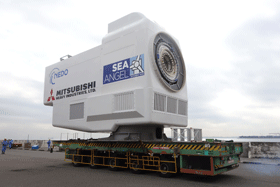
Mitsubishi Heavy Industries, Ltd. (MHI) commenced test operation at its Yokohama Dockyard & Machinery Works of a large scale, hydraulic drive train in place of a conventional gear-driven system.
In December, Mitsubishi Heavy Industries, Ltd. (MHI) commenced test operation at its Yokohama Dockyard & Machinery Works of a large scale, hydraulic drive train in place of a conventional gear-driven system. The test operation is a part of the project launched in September last year to develop a hydraulic drive train for offshore wind turbines. The work is supported by the New Energy and Industrial Technology Development Organization (NEDO). The event is said to mark a world’s first operation of a large-scale hydraulic drive train type wind power generation system applying MHI’s Digital Displacement Transmission. Leveraging the test results, MHI will accelerate its development of an offshore wind power generation system in the 7-MW range, with installation and operation slated to begin in the U.K. by end of 2013. A mass-produced commercial model is targeted for market launch in 2015.
The system recently inaugurated in Yokohama is based on an existing MWT100 gear-driven drive train retrofitted with new hydraulic version. Retrofitting involved replacing the gearbox – a speed increaser – that provided some 1,000 rpm to the generator. The company’s Digital Displacement Transmission hydraulic drive train will provide that function.
MHI developed the hydraulic drive train based on the digitally controlled hydraulic technologies of U.K. based Artemis Intelligent Power Ltd., a venture company acquired by MHI in 2010. The new system offers advantages over earlier systems. The hydraulic drive train, for example, provides, they say, outstanding efficiency and reliability by eliminating the conventional step-up gear and inverter, components that have been an issue in the quest for large-scale wind turbines. Also, the new configuration offers improved cost performance as a result of its incorporation of widely adopted hydraulic equipment, materials, and relatively inexpensive alternators.
MHI launched development of wind turbine in 1980. Its worldwide deliveries to date exceed 4,000 units with a collective output of 412.4 MW. With the test operation results of the latest unit at Yokohama, the company will move swiftly forward in its development of the new type system in order to respond to the schedules of the two projects: the operation of onshore demonstration unit in the UK and an offshore floating wind farm project in Fukushima, Japan. The new installations are slated to begin trial operations in June 2013 and August 2014, respectively.
Mitsubishi Heavy Industries
www.mhi.com
Filed Under: Hydraulics, News, Turbines






Obama’s energy policy is right. Japan’s FiT in July is among the highest in the world. Japan’s FiT is shaking the renewable energy market. New solutions will be showed in Japan. This is it! Floating wind turbine is one of the best solutions for USA and UK. UK has more install places around its shores than any other in the world. USA has Atlantic Coast. As you know, Every year Some typhoons arrive Japan. The typhoon has strong wind. Floating wind turbines must have constructed to resist typhoons. So they have to reduce vibration to install floating wind turbines on the sea. Because, it makes many kinds of problems! It’s increasing the durability problem of floating wind turbine. Vibration’s caused by wind, waves and external forces. New Floating Body Stabilizer for floating wind turbines has been created in South Korea. The Floating Body Stabilizers generate drag force immediately when floating wind turbines are being rolled, pitched and yawed on the water. Recently, this Floating Body Stabilizers have been used to reduce vibration of floating solar panels in South Korea. You can see New Floating Body Stabilizer videos in YouTube. http://youtu.be/O2oys_YHhCc, http://www.youtube.com/watch?v=nA_xFp5ktbU&feature=youtu.be.